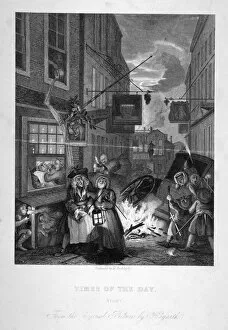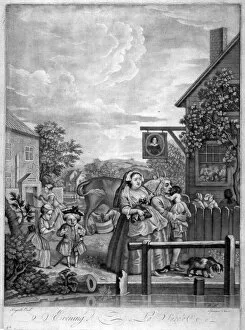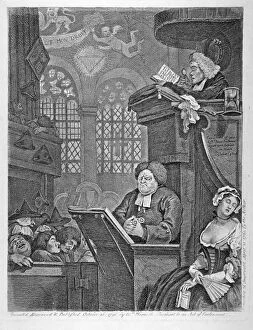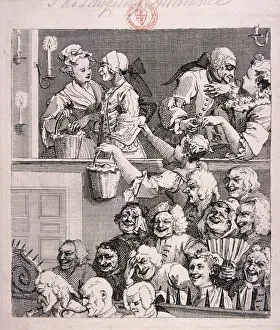William Hogarth Collection (#26)
William Hogarth (1697-1764) was an English painter, printmaker, and social critic
1,553 Items
All Professionally Made to Order for Quick Shipping
-
William Hogarth Collection
William Hogarth (1697-1764) was an English painter, printmaker, and social critic. He is considered one of the most important figures in the history of British art. His works often satirized contemporary politics and culture, with a focus on London life. He is best known for his series of paintings depicting scenes from the lives of Londoners in the 18th century, such as The Rake's Progress and Marriage A-la-Mode. Hogarth also created prints that were widely distributed throughout Europe and had a significant influence on other artists. His works are still highly regarded today for their insight into 18th century society and their technical skill in composition and execution.
+
Our beautiful Wall Art and Photo Gifts include Framed Prints, Photo Prints, Poster Prints, Canvas Prints, Jigsaw Puzzles, Metal Prints and so much more
Media Storehouse offers a vast collection of William Hogarth's artwork, which includes wall art, framed prints, photo prints, canvas prints, jigsaw puzzles and greeting cards. William Hogarth was an English painter and printmaker who lived in the 18th century. He is known for his satirical depictions of contemporary life in London. Our collection features some of his most famous works such as "Gin Lane" and "Beer Street," which depict the social problems caused by alcohol consumption during that time period. Other notable pieces include "Marriage A-la-Mode," a series of six paintings that satirize arranged marriages among the wealthy. All items are available for personal use only and cannot be used commercially without permission from Media Storehouse. Our collection does not offer acrylic prints or shipping services but provides high-quality reproductions of Hogarth's work suitable for display in any home or office setting.
+
What are William Hogarth (London England United Kingdom Europe) art prints?
William Hogarth was an English painter, printmaker and engraver who lived in the 18th century. He is known for his satirical and moralistic artworks that depicted everyday life in London during his time. His art prints are highly sought after by collectors and enthusiasts alike because of their historical significance and artistic value. We offer a wide range of William Hogarth's art prints that showcase his unique style and technique. These prints are reproduced using high-quality materials to ensure that they capture the essence of the original artwork. They come in various sizes, making them suitable for different display options such as framing or mounting on walls. Some of Hogarth's most famous works include "The Rake's Progress," "Marriage A-la-Mode," and "Gin Lane." These pieces offer a glimpse into the social issues prevalent during his era, including poverty, alcoholism, prostitution, and corruption. William Hogarth's art prints serve as a testament to his legacy as one of England's greatest artists whose influence can still be felt today.
+
What William Hogarth (London England United Kingdom Europe) art prints can I buy from Media Storehouse?
We offer a wide range of William Hogarth art prints for purchase. Some of the most popular prints include "The Rake's Progress," a series of eight paintings depicting the downfall of a young man who inherits a fortune, and "Gin Lane," which portrays the devastating effects of alcoholism on society. Other notable works available for purchase include "Marriage A-la-Mode," a satirical commentary on arranged marriages among the wealthy, and "The Four Stages of Cruelty," which depicts the progression from animal cruelty to murder. In addition to these well-known pieces, Media Storehouse also offers many other Hogarth prints that showcase his unique style and social commentary. Whether you are looking for humorous caricatures or thought-provoking scenes from everyday life in 18th century London, there is sure to be something that catches your eye in their collection.
+
How do I buy William Hogarth (London England United Kingdom Europe) art prints?
To buy William Hogarth art prints from Media Storehouse, you can browse our extensive collection of artwork online. Once you have found the print that you are interested in purchasing, simply add it to your cart and proceed to checkout. You will need to provide your shipping information and payment details at this stage. We offer a range of sizes and framing options for their prints, so be sure to select the one that best suits your needs. We also offer a variety of paper types, including fine art paper and photographic paper. If you have any questions or concerns about the ordering process or the artwork itself, we have a customer service team available to assist you. They can help with everything from selecting the right print to answering questions about shipping and delivery. Buying William Hogarth art prints from Media Storehouse is a simple and straightforward process that allows you to bring beautiful works of art into your home or office.
+
How much do William Hogarth (London England United Kingdom Europe) art prints cost?
We offer a wide range of William Hogarth art prints for purchase. The cost of these prints varies depending on the size and type of print selected. We have options available in various sizes including small, medium, large and extra-large to suit different preferences and budgets. Our selection includes both framed and unframed prints. William Hogarth was an influential artist from London, England who created satirical works during the 18th century. His artwork is highly regarded for its social commentary and unique style. We are proud to offer a diverse collection of his work that showcases his talent as an artist. Our you can browse our extensive collection online or visit one of our physical locations to view our selection in person. We strive to provide high-quality art prints at affordable prices so that everyone can enjoy the beauty and creativity of William Hogarth's work in their own homes or offices.
+
How will my William Hogarth (London England United Kingdom Europe) art prints be delivered to me?
We take great care in ensuring that your William Hogarth art prints are delivered to you safely and securely. We use high-quality packaging materials to protect your artwork during transit, including sturdy cardboard tubes for rolled prints and protective envelopes or boxes for framed prints. Our delivery partners are experienced in handling fragile items such as art prints, and they will ensure that your order is delivered to you promptly and efficiently. You can track the progress of your delivery online using our tracking service, which will provide you with real-time updates on the status of your order. We understand how important it is to receive your artwork in perfect condition, so if there are any issues with the quality or condition of your print upon arrival, please contact us immediately so we can resolve the issue as quickly as possible.
















































